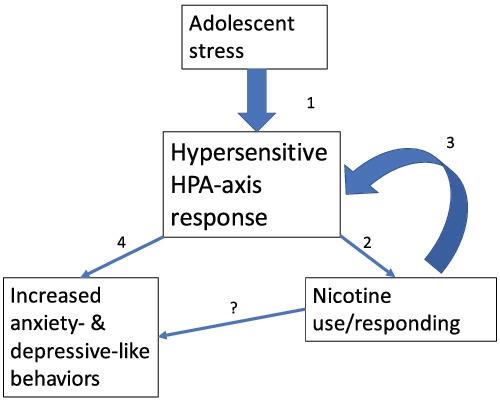当前位置:
X-MOL 学术
›
Eur. J. Nerosci.
›
论文详情
Our official English website, www.x-mol.net, welcomes your feedback! (Note: you will need to create a separate account there.)
The impact of adolescent stress on nicotine use and affective disorders in rodent models
European Journal of Neroscience ( IF 3.4 ) Pub Date : 2021-08-17 , DOI: 10.1111/ejn.15421 Sean M Mooney-Leber 1, 2 , Michael J Caruso 1 , Thomas J Gould 1 , Sonia A Cavigelli 1, 3 , Helen M Kamens 1, 3
European Journal of Neroscience ( IF 3.4 ) Pub Date : 2021-08-17 , DOI: 10.1111/ejn.15421 Sean M Mooney-Leber 1, 2 , Michael J Caruso 1 , Thomas J Gould 1 , Sonia A Cavigelli 1, 3 , Helen M Kamens 1, 3
Affiliation

|
Recent findings indicate that stress exposure during adolescence contributes to the development of both nicotine use and affective disorders, suggesting a potential shared biological pathway. One key system that may mediate the association between adolescent stress and nicotine or affective outcomes is the hypothalamic–pituitary–adrenal (HPA) axis. Here we reviewed evidence regarding the effects of adolescent stress on nicotine responses and affective phenotypes and the role of the HPA-axis in these relationships. Literature indicates that stress, possibly via HPA-axis dysfunction, is a risk factor for both nicotine use and affective disorders. In rodent models, adolescent stress modulates behavioural responses to nicotine and increases the likelihood of affective disorders. The exact role that the HPA-axis plays in altering nicotine sensitivity and affective disorder development after adolescent stress remains unclear. However, it appears likely that adolescent stress-induced nicotine use and affective disorders are precipitated by repetitive activation of a hyperactive HPA-axis. Together, these preclinical studies indicate that adolescent stress is a risk factor for nicotine use and anxiety/depression phenotypes. The findings summarized here suggest that the HPA-axis mediates this relationship. Future studies that pharmacologically manipulate the HPA-axis during and after adolescent stress are critical to elucidate the exact role that the HPA-axis plays in the development of nicotine use and affective disorders following adolescent stress.
中文翻译:

青春期压力对啮齿动物模型中尼古丁使用和情感障碍的影响
最近的研究结果表明,青春期的压力暴露有助于尼古丁使用和情感障碍的发展,这表明潜在的共同生物学途径。可能调节青少年压力与尼古丁或情感结果之间关联的一个关键系统是下丘脑-垂体-肾上腺 (HPA) 轴。在这里,我们回顾了有关青少年压力对尼古丁反应和情感表型的影响以及 HPA 轴在这些关系中的作用的证据。文献表明压力,可能通过 HPA 轴功能障碍,是尼古丁使用和情感障碍的危险因素。在啮齿动物模型中,青春期压力会调节对尼古丁的行为反应并增加情感障碍的可能性。HPA 轴在青少年压力后改变尼古丁敏感性和情感障碍发展中所起的确切作用仍不清楚。然而,青少年压力诱导的尼古丁使用和情感障碍似乎是由过度活跃的 HPA 轴的重复激活引起的。总之,这些临床前研究表明,青少年压力是尼古丁使用和焦虑/抑郁表型的危险因素。此处总结的发现表明 HPA 轴介导了这种关系。未来在青春期压力期间和之后对 HPA 轴进行药理学操作的研究对于阐明 HPA 轴在青少年压力后尼古丁使用和情感障碍的发展中所起的确切作用至关重要。然而,青少年压力诱导的尼古丁使用和情感障碍似乎是由过度活跃的 HPA 轴的重复激活引起的。总之,这些临床前研究表明,青少年压力是尼古丁使用和焦虑/抑郁表型的危险因素。此处总结的发现表明 HPA 轴介导了这种关系。未来在青春期压力期间和之后对 HPA 轴进行药理学操作的研究对于阐明 HPA 轴在青少年压力后尼古丁使用和情感障碍的发展中所起的确切作用至关重要。然而,青少年压力诱导的尼古丁使用和情感障碍似乎是由过度活跃的 HPA 轴的重复激活引起的。总之,这些临床前研究表明,青少年压力是尼古丁使用和焦虑/抑郁表型的危险因素。此处总结的发现表明 HPA 轴介导了这种关系。未来在青春期压力期间和之后对 HPA 轴进行药理学操作的研究对于阐明 HPA 轴在青少年压力后尼古丁使用和情感障碍的发展中所起的确切作用至关重要。这些临床前研究表明,青少年压力是尼古丁使用和焦虑/抑郁表型的危险因素。此处总结的发现表明 HPA 轴介导了这种关系。未来在青春期压力期间和之后对 HPA 轴进行药理学操作的研究对于阐明 HPA 轴在青少年压力后尼古丁使用和情感障碍的发展中所起的确切作用至关重要。这些临床前研究表明,青少年压力是尼古丁使用和焦虑/抑郁表型的危险因素。此处总结的发现表明 HPA 轴介导了这种关系。未来在青春期压力期间和之后对 HPA 轴进行药理学操作的研究对于阐明 HPA 轴在青少年压力后尼古丁使用和情感障碍的发展中所起的确切作用至关重要。
更新日期:2021-08-17
中文翻译:

青春期压力对啮齿动物模型中尼古丁使用和情感障碍的影响
最近的研究结果表明,青春期的压力暴露有助于尼古丁使用和情感障碍的发展,这表明潜在的共同生物学途径。可能调节青少年压力与尼古丁或情感结果之间关联的一个关键系统是下丘脑-垂体-肾上腺 (HPA) 轴。在这里,我们回顾了有关青少年压力对尼古丁反应和情感表型的影响以及 HPA 轴在这些关系中的作用的证据。文献表明压力,可能通过 HPA 轴功能障碍,是尼古丁使用和情感障碍的危险因素。在啮齿动物模型中,青春期压力会调节对尼古丁的行为反应并增加情感障碍的可能性。HPA 轴在青少年压力后改变尼古丁敏感性和情感障碍发展中所起的确切作用仍不清楚。然而,青少年压力诱导的尼古丁使用和情感障碍似乎是由过度活跃的 HPA 轴的重复激活引起的。总之,这些临床前研究表明,青少年压力是尼古丁使用和焦虑/抑郁表型的危险因素。此处总结的发现表明 HPA 轴介导了这种关系。未来在青春期压力期间和之后对 HPA 轴进行药理学操作的研究对于阐明 HPA 轴在青少年压力后尼古丁使用和情感障碍的发展中所起的确切作用至关重要。然而,青少年压力诱导的尼古丁使用和情感障碍似乎是由过度活跃的 HPA 轴的重复激活引起的。总之,这些临床前研究表明,青少年压力是尼古丁使用和焦虑/抑郁表型的危险因素。此处总结的发现表明 HPA 轴介导了这种关系。未来在青春期压力期间和之后对 HPA 轴进行药理学操作的研究对于阐明 HPA 轴在青少年压力后尼古丁使用和情感障碍的发展中所起的确切作用至关重要。然而,青少年压力诱导的尼古丁使用和情感障碍似乎是由过度活跃的 HPA 轴的重复激活引起的。总之,这些临床前研究表明,青少年压力是尼古丁使用和焦虑/抑郁表型的危险因素。此处总结的发现表明 HPA 轴介导了这种关系。未来在青春期压力期间和之后对 HPA 轴进行药理学操作的研究对于阐明 HPA 轴在青少年压力后尼古丁使用和情感障碍的发展中所起的确切作用至关重要。这些临床前研究表明,青少年压力是尼古丁使用和焦虑/抑郁表型的危险因素。此处总结的发现表明 HPA 轴介导了这种关系。未来在青春期压力期间和之后对 HPA 轴进行药理学操作的研究对于阐明 HPA 轴在青少年压力后尼古丁使用和情感障碍的发展中所起的确切作用至关重要。这些临床前研究表明,青少年压力是尼古丁使用和焦虑/抑郁表型的危险因素。此处总结的发现表明 HPA 轴介导了这种关系。未来在青春期压力期间和之后对 HPA 轴进行药理学操作的研究对于阐明 HPA 轴在青少年压力后尼古丁使用和情感障碍的发展中所起的确切作用至关重要。


























 京公网安备 11010802027423号
京公网安备 11010802027423号